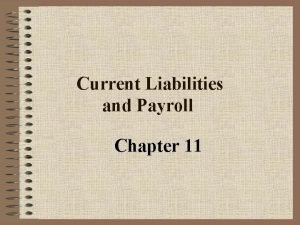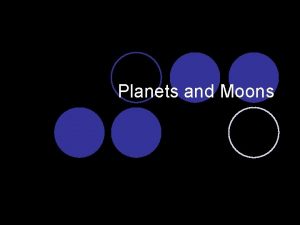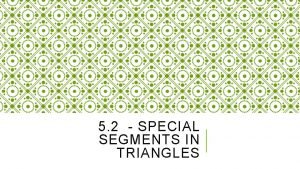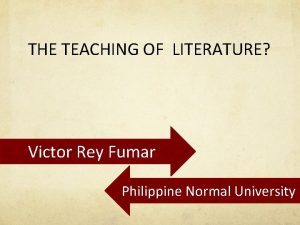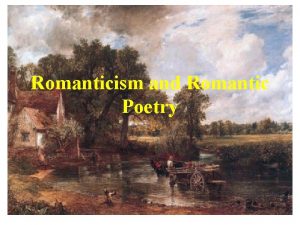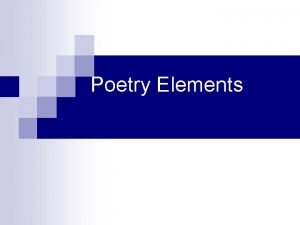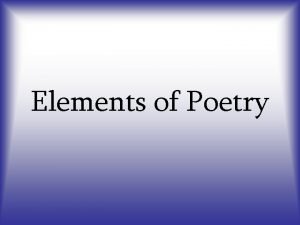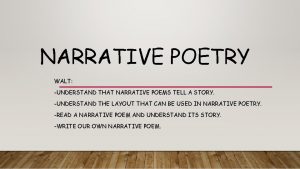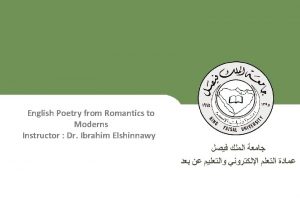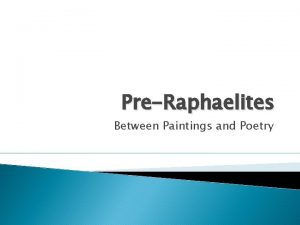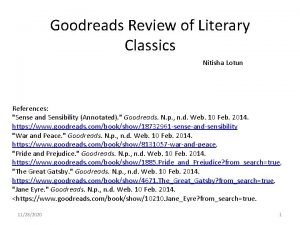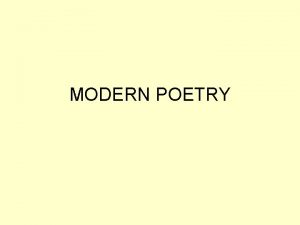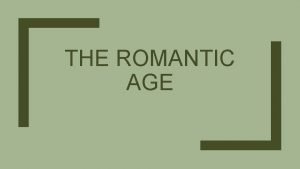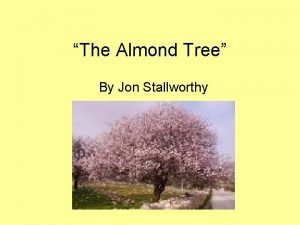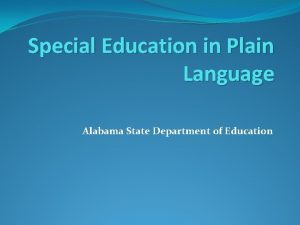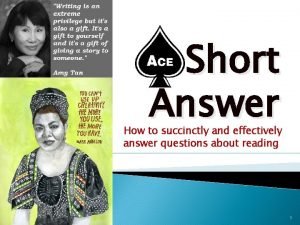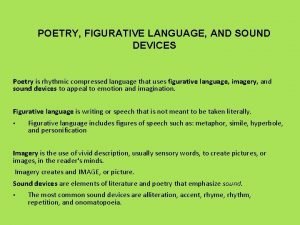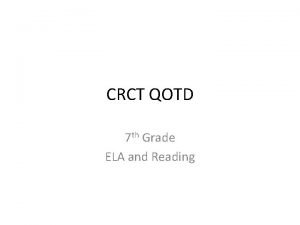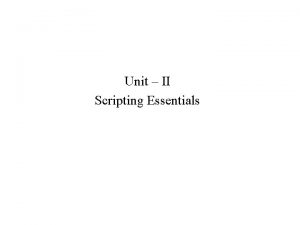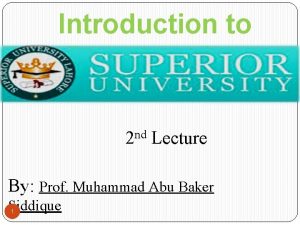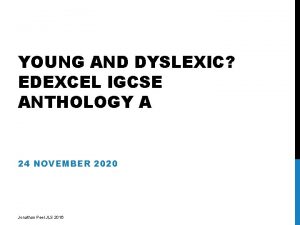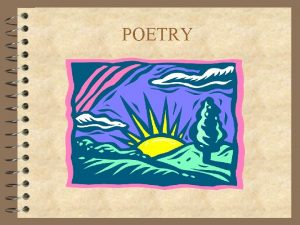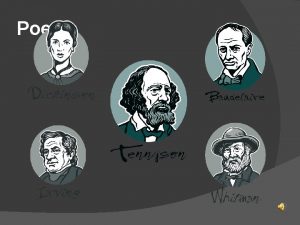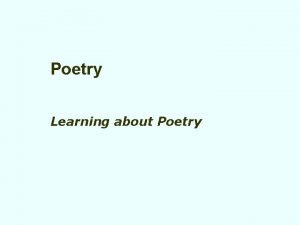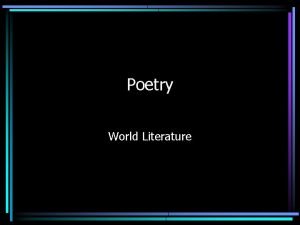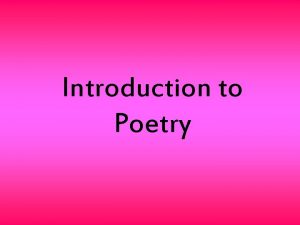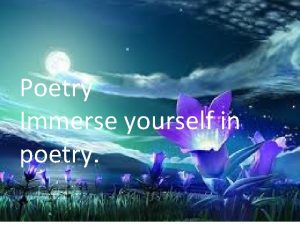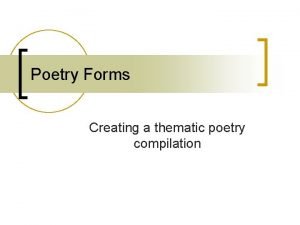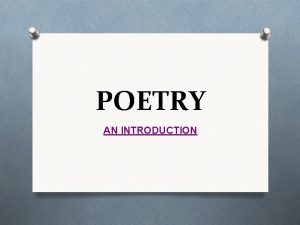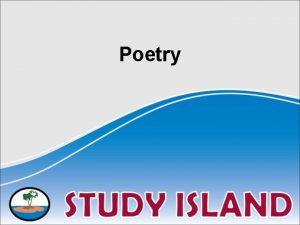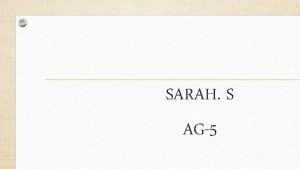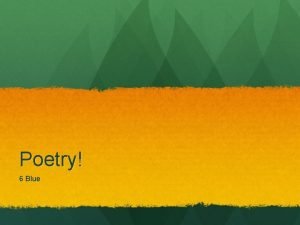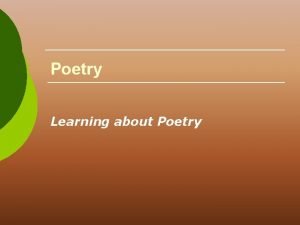Review Features of Poetry Special uses of language
































- Slides: 32

Review: Features of Poetry • Special uses of language – Compression of meaning – Patterns of sound – Connotation • • Rhythm and meter Rhyme Major genres: narrative and lyric Recurring/Associated themes

Review: Major Terms • • • alliteration enjambment foot (iambus) iambic pentameter pararhyme • • • quatrain rhyme scheme syllable (accented) stanza stress tone

Stressed and Unstressed Syllables • Accented syllables are called stressed syllables. • Unaccented syllables are called unstressed syllables. • Regular patterns of poetic feet is called meter. • Meter can be diagrammed; it demonstrates the basis of much English verse (accentualsyllabic)

Rhyme, Rhyme Scheme, Pararhyme • Rhyming words sound the same when spoken. • End rhyme appears at the end of lines. • Rhyme scheme is diagrammed with letters. Rhyming words get the same letter. • Partial or imperfect rhyme is called pararhyme. It is diagrammed with fractions.

“With Rue My Heart Is Laden” With rue my heart is laden For golden friends I had, For many a rose-lipt maiden And many a lightfoot lad. a b By brooks too broad for leaping, The lightfoot boys are laid; The rose-lipt girls are sleeping In fields where roses fade. c d

“So We’ll Go No More A-Roving” So we’ll go no more a-roving So late into the night, Though the heart be still as loving, And the moon be still as bright. For the sword outwears its sheath, And the soul wears out the breast, And the heart must pause to breathe, And love itself have rest. Though the night was made for loving, And the day returns too soon, Yet we’ll go no more a-roving By the light of the moon. a b 3/4 a b c d 3/4 a e

William Shakespeare (1564 -1616)

Sonnet 73 That time of year thou mayst in me behold When yellow leaves, or none, or few, do hang Upon those boughs which shake against the cold, Bare ruined choirs, where late the sweet birds sang. In me thou see’st the twilight of such day As after sunset fadeth in the west; Which by and by black night doth take away, Death’s second self, that seals up all in rest.

Sonnet 73 In me thou see’st the glowing of such fire, That on the ashes of his youth doth lie, As the death-bed whereon it must expire, Consumed with that which it was nourished by. This thou perceiv’st, which makes thy love more strong, To love that well which thou must leave ere long.

Approaches • We will consider: – form (metrical and rhyming arrangements) – semantics (including tone) – structure – technique (metaphor, simile, etc. )

Poetic Form • Count the syllables in a few lines. • Determine the number of accents in a few lines. • Based upon patterns of accents, determine whethere is a dominant meter. • Diagram the rhyme scheme.

Semantics • Restate the poem in non-poetic language. • Try to note how meaning is sectionalized.

Time Structure • What time words or other indications of time occur in the poem? • Each quatrain presents a specific and separate example of time’s passage. • Shakespeare has arranged them to call attention to the differences among them as well as their similarities.

Metaphor and Simile • Metaphor implies a direct comparison between two nominally dissimilar things. • Simile creates such connections with the use of certain words: – like – as – such

Examples • The day is dying. (metaphor) • The moon is like a ball. (simile)

Meaning and Metaphor • Identify the metaphors in this poem. • When metaphors are related, developed, and extended, we collectively call them a conceit.

Tone and Theme • What is the tone of this poem? • What is the relation between death and love in this poem?

Audience • To whom could the poet be speaking? • If there is advice at the end (that is, if that is how we read it), why might this advice not match our expectations—expectations from a more conventional poem and poet?

Langston Hughes (1902 -1967)


Harlem in Manhattan

Harlem

Free Verse • Free verse is a type of poetry that differs from conventional verse forms in being “free” from a fixed pattern of meter and rhyme, depending for its effects on other patterns of rhythm and sound.

Stanza One Here on the edge of hell Stands Harlem-Remembering the old lies, The old kicks in the back, The, Be patient, They told us before.

Stanza Two Sure, we remember. Now, when the man at the corner store Says sugar’s gone up another two cents, And bread one, And there’s a new tax on cigarettes— We remember the job we never had, Never could get, And can’t have now Because we’re colored.

Stanza Three So we stand here On the edge of hell In Harlem And look on the world And wonder What we’re gonna do In the face of What we remember.

Form • Why does this poem present difficulties not found in Shakespeare? • What formally can we look for to begin the interpretation process?

Stanza Progression • What do the stanzas share? • How do they differ? • Do you see a process or development in the stanzas?

Tone • • What is the overall tone of the poem? Is it threatening, for instance? How is tone possibly connected to purpose? Note that purpose is linked to audience—why might this be more difficult to determine for this poem?

Some Directions • Flow: caesurae and enjambment • Repetition: recurrence of diction; semantic shift in diction • Agency: subject of action; object of action • Time indicators • Identity: place, human identity

Make Up Class • No class on April 14. • Class will resume with poetry 02 on April 21. • I will hold a make up class (poetry 03) in this classroom on Saturday, April 22 from 10: 0011: 50.

For Next Time • Continue with poetry (genre): Light and nonsense verse, Housman, Hardy
 If a company uses a special payroll bank account:
If a company uses a special payroll bank account: Dances that are performed during wedding feast
Dances that are performed during wedding feast Feature of mercury
Feature of mercury Special segments test review
Special segments test review Doodle fiction examples in the philippines
Doodle fiction examples in the philippines Features of romantic poetry
Features of romantic poetry Abcb rhyme
Abcb rhyme Poetic element
Poetic element Define unseen
Define unseen Features of narrative poem
Features of narrative poem Victorian poetry characteristics
Victorian poetry characteristics Features of pre raphaelite poetry
Features of pre raphaelite poetry Unique features of book review
Unique features of book review Poetry character cavalier
Poetry character cavalier Traditional poetry vs modern poetry
Traditional poetry vs modern poetry Narrative and lyric poetry
Narrative and lyric poetry Augustan poetry aim
Augustan poetry aim The almond tree poem
The almond tree poem Chapter review motion part a vocabulary review answer key
Chapter review motion part a vocabulary review answer key Ap gov review final exam review
Ap gov review final exam review Nader amin-salehi
Nader amin-salehi Inclusion criteria examples
Inclusion criteria examples Narrative review vs systematic review
Narrative review vs systematic review Special education in plain language
Special education in plain language Sela texas education agency
Sela texas education agency Champion of the world maya angelou questions and answers
Champion of the world maya angelou questions and answers Figurative and sound devices
Figurative and sound devices Which sentence uses the most precise language?
Which sentence uses the most precise language? What are the uses of im language
What are the uses of im language Formal vs informal communication
Formal vs informal communication Scripting language uses
Scripting language uses Assembly language uses easy-to-remember instructions called
Assembly language uses easy-to-remember instructions called Young and dyslexic poem
Young and dyslexic poem
